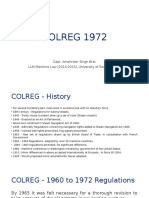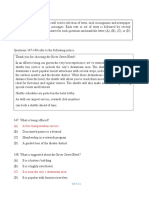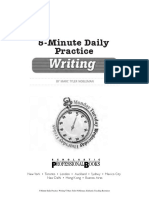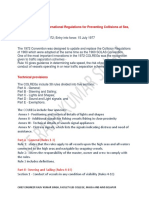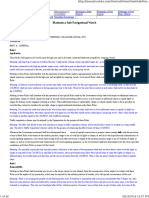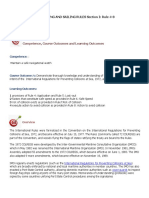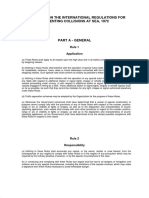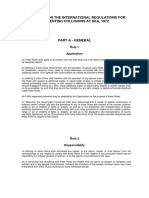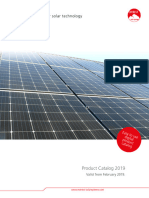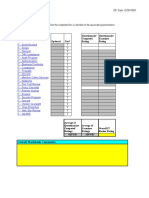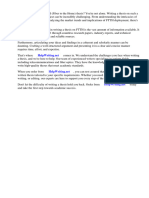COLREG
COLREG
Uploaded by
elmarCopyright:
Available Formats
COLREG
COLREG
Uploaded by
elmarCopyright
Available Formats
Share this document
Did you find this document useful?
Is this content inappropriate?
Copyright:
Available Formats
COLREG
COLREG
Uploaded by
elmarCopyright:
Available Formats
Convention on the International Regulations Part A - General (Rules 1-3)
for Preventing Collisions at Sea, 1972 Rule 1 states that the rules apply to all vessels
(COLREGs) upon the high seas and all waters connected
to the high seas and navigable by seagoing
Adoption: 20 October 1972; Entry into force:
vessels.
15 July 1977
Rule 2 covers the responsibility of the master,
The 1972 Convention was designed to update
owner and crew to comply with the rules.
and replace the Collision Regulations of 1960
which were adopted at the same time as the
1960 SOLAS Convention.
Rule 3 includes definitions.
One of the most important innovations in the
Part B- Steering and Sailing (Rules 4-19)
1972 COLREGs was the recognition given to
Section 1 - Conduct of vessels in any condition
traffic separation schemes - Rule 10 gives
of visibility (Rules 4-10)
guidance in determining safe speed, the risk
of collision and the conduct of vessels
operating in or near traffic separation
schemes. Rule 4 says the section applies in any
condition of visibility.
The first such traffic separation scheme was
established in the Dover Strait in 1967. It was Rule 5 requires that "every vessel shall at all
operated on a voluntary basis at first but in times maintain a proper look-out by sight and
1971 the IMO Assembly adopted a resolution hearing as well as by all available means
stating that that observance of all traffic appropriate in the prevailing circumstances
separation schemes be made mandatory - and and conditions so as to make a full appraisal
the COLREGs make this obligation clear. of the situation and of the risk of collision.
Technical provisions Rule 6 deals with safe speed. It requires that:
The COLREGs include 41 rules divided into six "Every vessel shall at all times proceed at a
sections: Part A - General; Part B - Steering safe speed...". The Rule describes the factors
and Sailing; Part C - Lights and Shapes; Part D - which should be taken into account in
Sound and Light signals; Part E - Exemptions; determining safe speed. Several of these refer
and Part F - Verification of compliance with specifically to vessels equipped with radar.The
the provisions of the Convention. There are importance of using "all available means" is
also four Annexes containing technical further stressed in
requirements concerning lights and shapes Rule 7 covering risk of collision, which warns
and their positioning; sound signalling that "assumptions shall not be made on the
appliances; additional signals for fishing basis of scanty information, especially scanty
vessels when operating in close proximity, radar information"
and international distress signals.
Rule 8 covers action to be taken to avoid separation schemes, this total was cut to only
collision. 16.
In Rule 9 a vessel proceeding along the course In other areas where such schemes did not
of a narrow channel or fairway is obliged to exist the number of collisions rose sharply.
keep "as near to the outer limit of the channel New traffic separation schemes are
or fairway which lies on her starboard side as introduced regularly and existing ones are
is safe and practicable." The same Rule amended when necessary to respond to
obliges a vessel of less than 20 metres in changed traffic conditions. To enable this to
length or a sailing vessel not to impede the be done as quickly as possible the MSC has
passage of a vessel "which can safely navigate been authorized to adopt and amend traffic
only within a narrow channel or fairway." separation schemes on behalf of the
Organization.
The Rule also forbids ships to cross a narrow
channel or fairway "if such crossing impedes Rule 10 states that ships crossing traffic lanes
the passage of a vessel which can safely are required to do so "as nearly as practicable
navigate only within such channel or fairway." at right angles to the general direction of
The meaning "not to impede" was classified traffic flow." This reduces confusion to other
by an amendment to Rule 8 in 1987. A new ships as to the crossing vessel's intentions and
paragraph (f) was added, stressing that a course and at the same time enables that
vessel which was required not to impede the vessel to cross the lane as quickly as possible.
passage of another vessel should take early
action to allow sufficient sea room for the
safe passage of the other vessel. Such vessel Fishing vessels "shall not impede the passage
was obliged to fulfil this obligation also when of any vessel following a traffic lane" but are
taking avoiding action in accordance with the not banned from fishing. This is in line with
steering and sailing rules when risk of collision Rule 9 which states that "a vessel engaged in
exists. fishing shall not impede the passage of any
other vessel navigating within a narrow
channel or fairway."In 1981 the regulations
Rule 10 of the Collision Regulations deals with were amended. Two new paragraphs were
the behaviour of vessels in or near traffic added to Rule 10 to exempt vessels which are
separation schemes adopted by the restricted in their ability to manoeuvre "when
Organization. By regulation 8 of Chapter V engaged in an operation for the safety of
(Safety of Navigation) of SOLAS, IMO is navigation in a traffic separation scheme" or
recognized as being the only organization when engaged in cable laying.
competent to deal with international
measures concerning the routeing of ships.
In 1987 the regulations were again amended.
The effectiveness of traffic separation
It was stressed that Rule 10 applies to traffic
schemes can be judged from a study made by
separation schemes adopted by the
the International Association of Institutes of
Organization (IMO) and does not relieve any
Navigation (IAIN) in 1981. This showed that
vessel of her obligation under any other rule.
between 1956 and 1960 there were 60
It was also to clarify that if a vessel is obliged
collisions in the Strait of Dover; twenty years
to cross traffic lanes it should do so as nearly
later, following the introduction of traffic
as practicable at right angles to the general circumstances and restricted visibility. A
direction of the traffic flow. In 1989 vessel detecting by radar another vessel
Regulation 10 was further amended to clarify should determine if there is risk of collision
the vessels which may use the "inshore traffic and if so take avoiding action. A vessel
zone." hearing fog signal of another vessel should
reduce speed to a minimum.
Section II - Conduct of vessels in sight of one
another (Rules 11-18) Part C Lights and Shapes (Rules 20-31)
Rule 11 says the section applies to vessels in Rule 20 states rules concerning lights apply
sight of one another. from sunset to sunrise.Rule 21 gives
definitions.
Rule 12 states action to be taken when two
sailing vessels are approaching one another. Rule 22 covers visibility of lights - indicating
that lights should be visible at minimum
ranges (in nautical miles) determined
Rule 13covers overtaking - the overtaking according to the type of vessel.
vessel should keep out of the way of the
vessel being overtaken.
Rule 23 covers lights to be carried by power-
driven vessels underway.
Rule 14 deals with head-on situations.
Crossing situations are covered by Rule 15
and action to be taken by the give-way vessel
Rule 24 covers lights for vessels towing and
is laid down in Rule 16.
pushing.
Rule 17 deals with the action of the stand-on
Rule 25 covers light requirements for sailing
vessel, including the provision that the stand-
vessels underway and vessels under oars.
on vessel may "take action to avoid collision
by her manoeuvre alone as soon as it
becomes apparent to her that the vessel
required to keep out of the way is not taking Rule 26 covers light requirements for fishing
appropriate action. vessels.
Rule 18 deals with responsibilities between Rule 27 covers light requirements for vessels
vessels and includes requirements for vessels not under command or restricted in their
which shall keep out of the way of others. ability to manoeuvre.
Section III - conduct of vessels in restricted Rule 28 covers light requirements for vessels
visibility (Rule 19) constrained by their draught.
Rule 19 states every vessel should proceed at
a safe speed adapted to prevailing
Rule 29 covers light requirements for pilot The Rules, adopted in 2013, bring in the
vessels. requirements for compulsory audit of Parties
to the Convention.
Rule 30 covers light requirements for vessels
anchored and aground.Rule 31 covers light Rule 39 provides definitions.
requirements for seaplanes
Rule 40 says that Contracting Parties shall use
Part D - Sound and Light Signals (Rules 32-37) the provisions of the Code for Implementation
in the execution of their obligations and
Rule 32 gives definitions of whistle, short
responsibilities contained in the present
blast, and prolonged blast.
Convention.
Rule 33 says vessels 12 metres or more in
Rule 41 on Verification of compliance says
length should carry a whistle and a bell and
that every Contracting Party is subject to
vessels 100 metres or more in length should
periodic audits by IMO.
carry in addition a gong.
Annexes
Rule 34 covers manoeuvring and warning
The COLREGs include four annexes:
signals, using whistle or lights.
Annex I - Positioning and technical details of
Rule 35 covers sound signals to be used in
lights and shapes
restricted visibility.
Annex II - Additional signals for fishing vessels
Rule 36 covers signals to be used to attract
fishing in close proximity
attention.
Annex III - Technical details of sounds signal
Rule 37 covers distress signals.
appliances
Part E - Exemptions (Rule 38)
Annex IV - Distress signals, which lists the
Rule 38 says ships which comply with the signals indicating distress and need of
1960 Collision Regulations and were built or assistance.
already under construction when the 1972
Collision Regulations entered into force may
be exempted from some requirements for
light and sound signals for specified periods.
Part F - Verification of compliance with the
provisions of the Convention
You might also like
- Marketing Strategies of ToyotaDocument53 pagesMarketing Strategies of ToyotaChandan Srivastava100% (1)
- APQP Process Flow MapDocument13 pagesAPQP Process Flow Mapjohnoo70% (1)
- Colreg 2002Document82 pagesColreg 2002heincpaing100% (3)
- Imo Colreg 1972Document80 pagesImo Colreg 1972Ali Movaghar100% (3)
- No. M.1642/COLREG 1: The Merchant Shipping (Distress Signals and Prevention of Collisions) Regulations 1996Document32 pagesNo. M.1642/COLREG 1: The Merchant Shipping (Distress Signals and Prevention of Collisions) Regulations 1996Polaris BridgemanNo ratings yet
- Test 3-Keys-P7Document26 pagesTest 3-Keys-P7Annh Điiền0% (1)
- Geometric ConstructionsDocument49 pagesGeometric Constructionsciki1100% (4)
- 5-Minute Daily Practice - Writing (NRevill v1)Document64 pages5-Minute Daily Practice - Writing (NRevill v1)Cristina Liliana93% (15)
- Colregs - ImoDocument9 pagesColregs - Imof66vq22594No ratings yet
- Part A - General (Rules 1-3)Document4 pagesPart A - General (Rules 1-3)kennybelloNo ratings yet
- Colreg Explanatory NotesDocument5 pagesColreg Explanatory Notesbradsean1350No ratings yet
- Colreg KonvencijaDocument11 pagesColreg KonvencijaDarko ErcegovicNo ratings yet
- A Project Presented To C/M Danilo Sunodan Technological Institute of The PhilippinesDocument8 pagesA Project Presented To C/M Danilo Sunodan Technological Institute of The PhilippinesGian Ronell LaurenariaNo ratings yet
- ColregDocument6 pagesColregCarl Joshua BallesterosNo ratings yet
- 2E NON - Collision RegulationsDocument5 pages2E NON - Collision RegulationsJeremy CuarterosNo ratings yet
- Colregs Rule 1-10Document2 pagesColregs Rule 1-10Romelo Jr. OfamenNo ratings yet
- Colreg Assignment by RakibDocument4 pagesColreg Assignment by Rakibmhrakib11423No ratings yet
- ColregDocument1 pageColregabd manafNo ratings yet
- ROR_expDocument46 pagesROR_expPoseidonNo ratings yet
- HISTORY OF COLLITION REGULATIONDocument64 pagesHISTORY OF COLLITION REGULATIONKate DabucolNo ratings yet
- Collision RegulationsDocument139 pagesCollision Regulationsmsk5in100% (6)
- Col RegsDocument17 pagesCol Regsim3670660No ratings yet
- PublicationDocument60 pagesPublicationkimcristobal52No ratings yet
- MGN 200 (M+F) : Observance of Traffic Separation SchemesDocument4 pagesMGN 200 (M+F) : Observance of Traffic Separation Schemesmohammad shrekyNo ratings yet
- 33 Mecolregs - 000 2Document46 pages33 Mecolregs - 000 2diegocely700615No ratings yet
- Safety of Autonomous Shipping: COLREGS and Interaction Between Manned and Unmanned ShipsDocument8 pagesSafety of Autonomous Shipping: COLREGS and Interaction Between Manned and Unmanned Shipsmohammad shrekyNo ratings yet
- Rule 10 - Traffic Separation SchemesDocument133 pagesRule 10 - Traffic Separation SchemesMitch Speeder100% (4)
- Convention On The International Regulations For Preventing Collisions at Sea, 1972 (Colregs)Document13 pagesConvention On The International Regulations For Preventing Collisions at Sea, 1972 (Colregs)kartikeya RanjanNo ratings yet
- Colreg 1972Document14 pagesColreg 1972Rafie Paqer100% (1)
- Unit 33 Collision Regulations (Colregs) Basic Terms: Rules Part A General 1 - 3 Part B Steering and Sailing RulesDocument34 pagesUnit 33 Collision Regulations (Colregs) Basic Terms: Rules Part A General 1 - 3 Part B Steering and Sailing RulesHassan SaidNo ratings yet
- Orca Share Media1685712847263 7070392138128247285Document62 pagesOrca Share Media1685712847263 7070392138128247285jessicamaeagujaNo ratings yet
- Vol-64 IV Alexander International StraitsDocument18 pagesVol-64 IV Alexander International StraitshimanshuNo ratings yet
- Collision Regulation Part 1 GeneralDocument19 pagesCollision Regulation Part 1 Generalaris renz sangalang100% (1)
- International Regulations For Preventing Collisions at Sea, 1972Document29 pagesInternational Regulations For Preventing Collisions at Sea, 1972manos8100% (1)
- NchimbiDocument2 pagesNchimbilyimohilary472No ratings yet
- Col RegsDocument46 pagesCol RegsMaktrukNo ratings yet
- Chapter 1Document16 pagesChapter 1Radu GeorgeNo ratings yet
- Colregs 1972 Made EasyDocument94 pagesColregs 1972 Made EasyAley Nabi Rizvi100% (1)
- Lesson - 2 DWATCHDocument5 pagesLesson - 2 DWATCHRonan John GuillanoNo ratings yet
- International Regulation For PreventDocument21 pagesInternational Regulation For PreventArsenR.MayoJr.No ratings yet
- COLREGS The Rules of The RoadDocument21 pagesCOLREGS The Rules of The RoadArsenR.MayoJr.100% (1)
- Dwatch Group 4Document21 pagesDwatch Group 4Alcai'100% (1)
- Colregs 1972 Made EasyDocument94 pagesColregs 1972 Made Easysamar jeet100% (1)
- Colregs 2016Document32 pagesColregs 2016Elias Salas Pye100% (1)
- DGS Collision RulesDocument30 pagesDGS Collision Rulesriz506No ratings yet
- Col RegsDocument2 pagesCol RegsweakacountNo ratings yet
- SOLAS CHAPTER 6 Group 4Document16 pagesSOLAS CHAPTER 6 Group 4Derla JunnielNo ratings yet
- ColregDocument21 pagesColregsailboat541No ratings yet
- International Rules COLREGDocument38 pagesInternational Rules COLREGAndrei Cristea100% (1)
- Deck Watch 2 Lecture 1Document47 pagesDeck Watch 2 Lecture 1Robert M. Maluya67% (3)
- Lesson - 1 DWATCHDocument8 pagesLesson - 1 DWATCHRonan John GuillanoNo ratings yet
- Nepomuceno, MarkJason LessonSummaryDocument3 pagesNepomuceno, MarkJason LessonSummaryMark Jason NepomucenoNo ratings yet
- Col Reg 1972Document87 pagesCol Reg 1972Ran Oronce100% (5)
- International Collision RegulationsDocument21 pagesInternational Collision RegulationsMcrislbNo ratings yet
- Colreg Week 1Document38 pagesColreg Week 1Paul Andrei Dellomas100% (2)
- Albofera AvoidingcollisionDocument6 pagesAlbofera AvoidingcollisionALBOFERA, PRAISE GEE L.No ratings yet
- 1521170229colregs Rule 1 - 38 PDFDocument34 pages1521170229colregs Rule 1 - 38 PDFRITESH marineNo ratings yet
- International Regulations for Preventing Collisions at SeaFrom EverandInternational Regulations for Preventing Collisions at SeaNo ratings yet
- Colreg Rules PDFDocument2 pagesColreg Rules PDFMichaelNo ratings yet
- COLREG 1972 원문Document29 pagesCOLREG 1972 원문jinjin6719No ratings yet
- Ror PDFDocument32 pagesRor PDFSaifur Rahman Bhuyan100% (2)
- International Rule 1 General: ColregDocument18 pagesInternational Rule 1 General: ColregLucian Oniscu100% (1)
- Colregs72 PDFDocument28 pagesColregs72 PDFCaptain MarjescoNo ratings yet
- Colregs72 BookDocument28 pagesColregs72 BookSherry GodwinNo ratings yet
- Legal Aspects of Marine AccidentsDocument12 pagesLegal Aspects of Marine AccidentsLolla MohamedNo ratings yet
- Career Counselling TheoriesDocument9 pagesCareer Counselling TheoriesgopipooganNo ratings yet
- Commas With AppositivesDocument15 pagesCommas With AppositivesLoven FlorencioNo ratings yet
- Kaiju UniverseDocument1 pageKaiju UniverseChin SehakvitouNo ratings yet
- EverestCatalog US01 0219Document35 pagesEverestCatalog US01 0219CESAR GONZALEZNo ratings yet
- Books Doubtnut Question BankDocument300 pagesBooks Doubtnut Question BankSatinder Singh ShishodiaNo ratings yet
- GDLab Brochure Call For Research Proposals (ENG)Document9 pagesGDLab Brochure Call For Research Proposals (ENG)Igor DantasNo ratings yet
- 12a - Dispersion ModellingDocument24 pages12a - Dispersion ModellingGAEL MICHEL-GROSJEANNo ratings yet
- Mind MapDocument1 pageMind MapRumbling QueenNo ratings yet
- 510-Article Text-745-1-10-20221011Document26 pages510-Article Text-745-1-10-20221011Russ VergaraNo ratings yet
- Linear Algebra For Machine LearningDocument5 pagesLinear Algebra For Machine LearningGeeta SinghNo ratings yet
- PPSC Challan Form PDFDocument1 pagePPSC Challan Form PDFANas AliNo ratings yet
- Snuggler Gear Reducer FA40A: Sew-Eurodrive, IncDocument2 pagesSnuggler Gear Reducer FA40A: Sew-Eurodrive, InccmaradiagaNo ratings yet
- Firewall Audit Checklist IT-QuestionnairesDocument55 pagesFirewall Audit Checklist IT-Questionnairessashi100% (1)
- Chi Square Test of Proportions For Confirmation Testing: Craig G. Hysong May 6, 2014Document44 pagesChi Square Test of Proportions For Confirmation Testing: Craig G. Hysong May 6, 2014MickloSoberanNo ratings yet
- Entrepreneurship Class Xii Worksheet - Chapter 1 - Entrepreneurial OpportunityDocument3 pagesEntrepreneurship Class Xii Worksheet - Chapter 1 - Entrepreneurial OpportunityHarshit JagetiaNo ratings yet
- FTTH ThesisDocument4 pagesFTTH Thesisdshyylbaf100% (1)
- Border Molding & Vent HolesDocument4 pagesBorder Molding & Vent HolesGina Kissey100% (1)
- Airport Marketing Route Development (Handout)Document27 pagesAirport Marketing Route Development (Handout)shokhbosmukhamedovNo ratings yet
- Multi Pump Head Vs Flow RateDocument8 pagesMulti Pump Head Vs Flow RateUzair BukhariNo ratings yet
- Incoterms 2020 - ENDocument1 pageIncoterms 2020 - ENHum92reNo ratings yet
- List of Components of Oil Drilling RigsDocument4 pagesList of Components of Oil Drilling RigsIjlal Ahmad100% (1)
- A14.00-2to4-4to6-36p-S2 White Plume Mountain ReconciledDocument36 pagesA14.00-2to4-4to6-36p-S2 White Plume Mountain ReconciledNoomaa LakeNo ratings yet
- Quality Assurance PlanDocument4 pagesQuality Assurance PlanNaveen NagisettiNo ratings yet
- Construction of A Cretan WindmillDocument57 pagesConstruction of A Cretan WindmillAgustín GiupponiNo ratings yet
- OceanofPDF.com Mr and Mrs Smith - Cathy East DubowskiDocument268 pagesOceanofPDF.com Mr and Mrs Smith - Cathy East Dubowskiiluvkpop87No ratings yet



